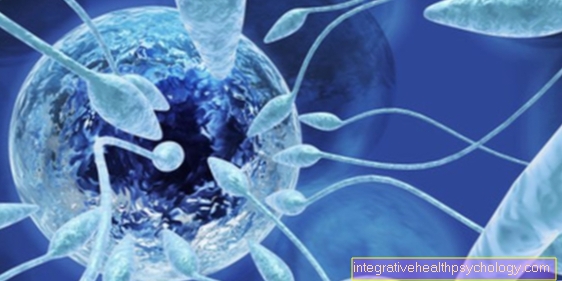Still disease
What is Still Disease?
Still's disease is also called systemic juvenile idiopathic arthritis designated. This is a rheumatic disease that affects not only the joints but also the organs. The word juvenile means that this is a childhood disease, less than one in 100,000 children in Europe develops Still's disease each year. So it is a rare disease.
Other variants of childhood rheumatism are more common and occur in around 10 out of 100,000 children. Still's disease - also known as Still syndrome - also occurs in adults and is then called adult Still's disease designated. Again, less than one in 100,000 people suffer from this disease each year.
With appropriate therapy, Still's disease has a relative good prognosis, but there are also difficult gradients.
We recommend that you first deal with the main topics in order to get general information:
- rheumatism
- Juvenile polyarthritis

I recognize Still's disease by these symptoms
In all diseases from the so-called rheumatic group - which also includes Still's disease - an inflammatory reaction in various joints typically occurs. The larger joints such as ankle, knee, hip, elbow, shoulder or wrist are particularly often affected.
There is pain, swelling, redness and overheating in the affected joint (s). In the case of children, this can be shown by refusing to run, for example. In Still's disease, however, these typical joint problems often only appear months after the onset of the disease. This makes it difficult to find a diagnosis.
The disease usually begins with bouts of high fever around 40 ° C, which mainly occurs in the morning and evening. The fever cannot be sufficiently reduced with conventional antipyretic drugs. Those affected often feel dull and exhausted,
Children can attract attention through reduced eating and drinking, increased need for sleep and increased screaming.
At the beginning, Still's disease often looks like an acute infection. This is accompanied by a salmon-colored, fine-spotted rash in the area of the stomach, chest and back, as well as upper arms and thighs. The rash is often itchy. At the onset of the disease, pain in the cervical spine can occur, for example when turning the head.
In Still's disease, inflammatory organ involvement typically also occurs. This can manifest itself in very different ways, depending on which organs are affected. Symptoms such as painful breathing due to inflammatory involvement of the lungs, heart problems due to inflammation of the pericardium and abdominal pain due to inflammation of the peritoneum appear.
In addition, there is typically a swelling of numerous lymph nodes distributed over the body (generalized lymph node swelling) and an enlargement of the spleen and liver (hepatosplenomegaly), which can become noticeable on an ultrasound examination of the abdomen (abdominal sonography).
Lymph node swelling can also indicate other dangerous diseases and should be examined by a doctor immediately if it stops. For this, read the article under: Chronic lymph node swelling - what's behind it?
Which organs can be affected by Still's disease?
It is characteristic of Still's disease that, in addition to the involvement of the joints, internal organs are also affected. Various organs can become inflamed as part of the disease and thus lead to complaints.
The most common of the inflammatory reaction are the peritoneum (peritonitis), the pericardium (pericarditis) and the lungs (pleurisy) affected. Possible symptoms are abdominal pain, heart problems or pain when breathing in deeply.
The spleen and liver are also often enlarged. However, this enlargement is not due to a direct inflammatory involvement of these organs.
Inflammatory involvement of the meninges can rarely occur in adults with Still's disease (meningitis) come.
Read additional information on the diseases mentioned above at:
- What is peritonitis?
- How does pericarditis express itself?
Treatment of Still's disease
There is no causal therapy that can cure Still's disease. However, there are numerous medications that can help prevent, or at least minimize, damage to joints and organs that would result from the constant inflammation.
Anti-inflammatory therapy of this kind is essential, especially for children who are still growing, as this can otherwise lead to permanent movement restrictions or misalignments. But anti-inflammatory therapy also plays an important role in maintaining quality of life for adults.
Medicines that are used to treat Still's disease are non-steroidal anti-inflammatory drugs (NSAIDs) such as ibuprofen, naproxen or diclofenac, glucocorticoids such as prednisolone or so-called basic therapeutic agents or disease-modifying anti-rheumatic drugs (DMARDs) such as methotrexate, sulfasalazine or azathioprine.
Usually a treatment attempt with NSAIDs is undertaken for a few weeks at the beginning, since these are the drugs with the fewest serious side effects. If no adequate improvement can be achieved, drugs from one of the other groups are used. Glucocorticoids are often highly effective and, because of their numerous undesirable effects, are given in long-term therapy, if possible, only as briefly as possible.
It is often necessary to start a therapy with glucocorticoids until the basic therapeutic agents have started to work. These have a delayed onset of action of a few weeks up to 3 months. They often have to be administered over several years.
As a relatively new treatment option for Still's disease, so-called biologics such as anakinra are increasingly coming to the fore. These are antibodies that bind to certain receptors or mediators of the inflammatory reaction and thus lead to inflammation inhibition.
In addition to drug therapy - especially with juvenile Still's disease - regular physical and occupational therapy play an important accompanying role.
You can find more information about the individual drugs at:
- Side Effects of Cortisone - Blessing or Curse?
Diagnosis of Still's disease
In order to arrive at the correct diagnosis, the exact anamnesis, i.e. the collection of the medical history, is crucial. The symptoms are particularly important here.
Various blood tests are also done. A significant increase in the inflammatory parameters in the blood is characteristic of Still's disease. These include the values CRP and sedimentation rate (BSG) and the number of white blood cells (Leukocytosis). In most cases, there is also an increase in the number of platelets (Thrombocytosis) and anemia (anemia) on.
Typically no antibodies typical for autoimmune diseases are detectable in the blood. However, these findings are not specific to the disease. There is no specific test that can detect Still's disease. Rather, a compilation and evaluation of various examinations ultimately leads to the diagnosis.
In the case of the child's form of Still's disease, the eyes are usually also examined in detail for further diagnosis, as various types of rheumatism in children can involve the eyes, which - if left untreated - can lead to loss of vision. Typically, there is no evidence of eye involvement in Still's disease.
Further examinations such as ultrasound of the abdomen or ultrasound / X-ray / MRT images of certain joints can be used to confirm the diagnosis.
For more detailed information on diagnosing Still's disease, see: Procedure of an MRI
Causes of Still Disease
The cause of Still's disease has not yet been fully clarified. It is a so-called multifactorial disease, i.e. a disease that arises from an interplay of many factors.
It can be assumed that certain genetic conditions increase the risk of developing Still's disease. If other factors are added, the disease breaks out.
The current state of research suggests that Still's disease is an autoimmune disease. This means that the body's own immune system falsely attacks structures in its own body and thus leads to repeated strong inflammatory reactions.
Read more about this at: Autoimmune Diseases - What is it?
Life expectancy in Still's disease
Life expectancy is usually not restricted by Still's disease - provided it is adequately treated. Due to the advances in anti-inflammatory and immunosuppressive therapy, the rate of lethal (fatal) complications has fallen significantly in the last few decades.
Only rarely are there highly complicated courses with a fatal outcome.
Course of the disease of Still's disease
In most cases, the illness begins with recurring attacks of fever and rashes, as well as fatigue and exhaustion. Joint problems often only manifest themselves months after the first symptoms appear.
The course of the disease and the prognosis vary greatly from person to person. In some cases the disease resolves completely in childhood and adolescence, in others it remains lifelong. A distinction is then made between a course in which the symptoms appear in recurring attacks, between which symptom-free weeks, months or years can lie, and a chronic course in which the symptoms persist.
In around 20-30% of affected patients, the disease is permanently suppressed (remission). About 40% of the sick suffer from only mild chronic inflammation of the joints, which can be managed well with drug therapy and supportive physiotherapy.
Symptoms in the organs can reappear in stages, but they can also be absent for years. There are also cases in which the disease can hardly be controlled by therapy and which is associated with increasing joint destruction and complications in the area of the organs.
Chances of recovery in Still's disease
Still's disease cannot be cured. At least not in the traditional sense.
There are patients who can be brought into remission by therapy. In this case, remission means that symptoms no longer occur and that the disease is completely under control. However, since it can flare up again at any time, we cannot speak of a cure in the traditional sense.
Can Still's Disease Be Fatal?
Yes. There are complications in the course of the disease that can be fatal.
This includes in particular the so-called macrophage activation syndrome, also known as hemophagocytic lymphohistiocytosis. In the context of Still's disease or in the context of a viral infection under immunosuppressive therapy for Still's disease, a massively excessive inflammatory reaction of the immune system occurs.
Persistent fever, enlargement of the spleen (splenomegaly) and various changes in the blood count occur. Finding a diagnosis is not always easy, since the clinical symptoms mentioned, i.e. fever and enlarged spleen, also occur in non-complicative Still's disease.Only the changes in the blood count then point in the direction of a macrophage activation syndrome. High-dose cortisone burst therapy, immunosuppressants and biologics are used therapeutically. The mortality of the macrophage activation syndrome is extremely high without appropriate therapy. But even with therapy, the mortality is up to 40%.

























.jpg)



